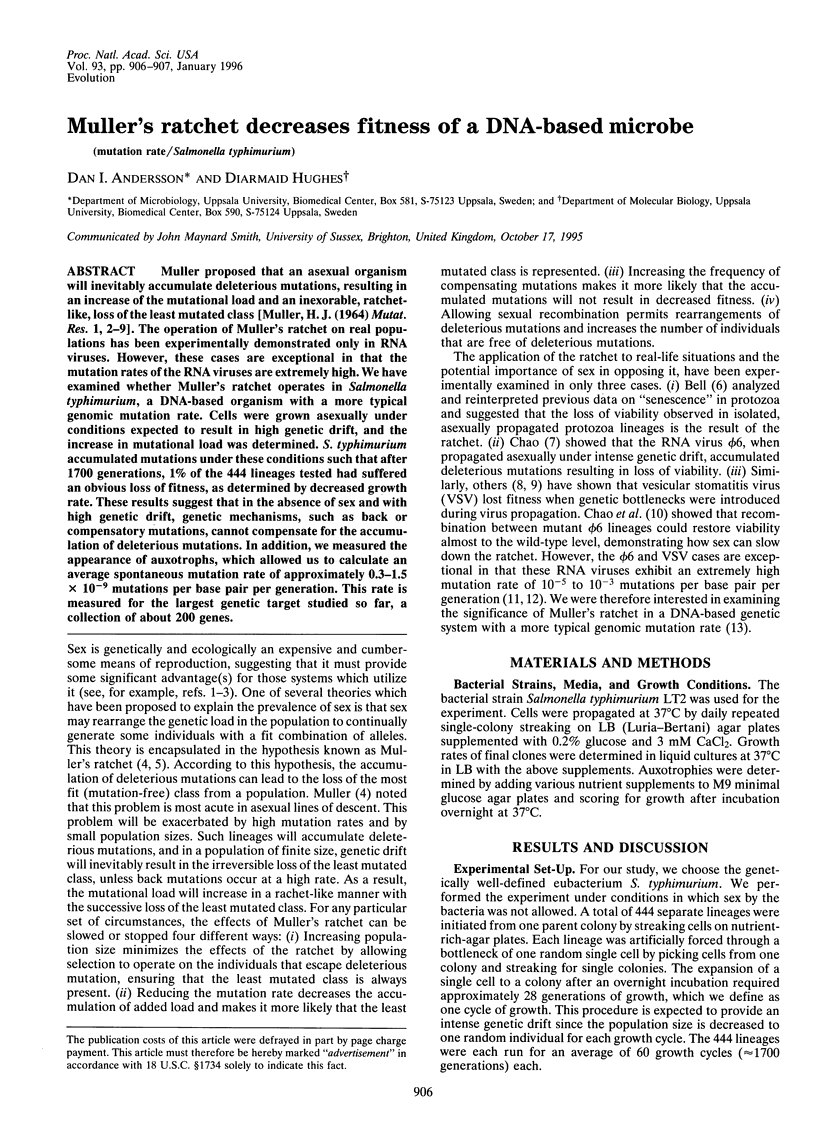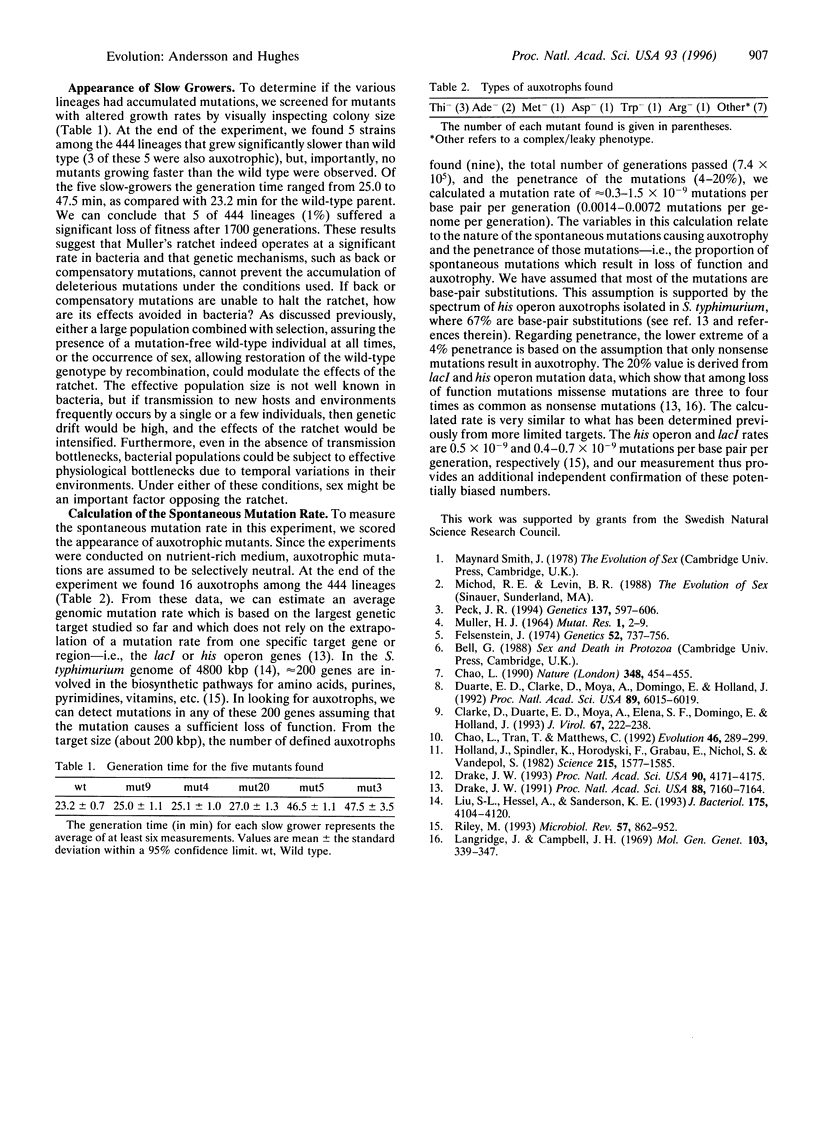Abstract
Muller proposed that an asexual organism will inevitably accumulate deleterious mutations, resulting in an increase of the mutational load and an inexorable, ratchet-like, loss of the least mutated class [Muller, H.J. (1964) Mutat. Res. 1, 2-9]. The operation of Muller's ratchet on real populations has been experimentally demonstrated only in RNA viruses. However, these cases are exceptional in that the mutation rates of the RNA viruses are extremely high. We have examined whether Muller's ratchet operates in Salmonella typhimurium, a DNA-based organism with a more typical genomic mutation rate. Cells were grown asexually under conditions expected to result in high genetic drift, and the increase in mutational load was determined. S. typhimurium accumulated mutations under these conditions such that after 1700 generations, 1% of the 444 lineages tested had suffered an obvious loss of fitness, as determined by decreased growth rate. These results suggest that in the absence of sex and with high genetic drift, genetic mechanisms, such as back or compensatory mutations, cannot compensate for the accumulation of deleterious mutations. In addition, we measured the appearance of auxotrophs, which allowed us to calculate an average spontaneous mutation rate of approximately 0.3-1.5 x 10(-9) mutations per base pair per generation. This rate is measured for the largest genetic target studied so far, a collection of about 200 genes.
Full text
PDF

Selected References
These references are in PubMed. This may not be the complete list of references from this article.
- Chao L. Fitness of RNA virus decreased by Muller's ratchet. Nature. 1990 Nov 29;348(6300):454–455. doi: 10.1038/348454a0. [DOI] [PubMed] [Google Scholar]
- Clarke D. K., Duarte E. A., Moya A., Elena S. F., Domingo E., Holland J. Genetic bottlenecks and population passages cause profound fitness differences in RNA viruses. J Virol. 1993 Jan;67(1):222–228. doi: 10.1128/jvi.67.1.222-228.1993. [DOI] [PMC free article] [PubMed] [Google Scholar]
- Drake J. W. A constant rate of spontaneous mutation in DNA-based microbes. Proc Natl Acad Sci U S A. 1991 Aug 15;88(16):7160–7164. doi: 10.1073/pnas.88.16.7160. [DOI] [PMC free article] [PubMed] [Google Scholar]
- Drake J. W. Rates of spontaneous mutation among RNA viruses. Proc Natl Acad Sci U S A. 1993 May 1;90(9):4171–4175. doi: 10.1073/pnas.90.9.4171. [DOI] [PMC free article] [PubMed] [Google Scholar]
- Duarte E., Clarke D., Moya A., Domingo E., Holland J. Rapid fitness losses in mammalian RNA virus clones due to Muller's ratchet. Proc Natl Acad Sci U S A. 1992 Jul 1;89(13):6015–6019. doi: 10.1073/pnas.89.13.6015. [DOI] [PMC free article] [PubMed] [Google Scholar]
- Felsenstein J. The evolutionary advantage of recombination. Genetics. 1974 Oct;78(2):737–756. doi: 10.1093/genetics/78.2.737. [DOI] [PMC free article] [PubMed] [Google Scholar]
- Holland J., Spindler K., Horodyski F., Grabau E., Nichol S., VandePol S. Rapid evolution of RNA genomes. Science. 1982 Mar 26;215(4540):1577–1585. doi: 10.1126/science.7041255. [DOI] [PubMed] [Google Scholar]
- Langridge J., Campbell J. H. Classification and intragenic position of mutations in the beta-galactosidase gene of Escherichia coli. Mol Gen Genet. 1969;103(4):339–347. doi: 10.1007/BF00383484. [DOI] [PubMed] [Google Scholar]
- Liu S. L., Hessel A., Sanderson K. E. The XbaI-BlnI-CeuI genomic cleavage map of Salmonella typhimurium LT2 determined by double digestion, end labelling, and pulsed-field gel electrophoresis. J Bacteriol. 1993 Jul;175(13):4104–4120. doi: 10.1128/jb.175.13.4104-4120.1993. [DOI] [PMC free article] [PubMed] [Google Scholar]
- MULLER H. J. THE RELATION OF RECOMBINATION TO MUTATIONAL ADVANCE. Mutat Res. 1964 May;106:2–9. doi: 10.1016/0027-5107(64)90047-8. [DOI] [PubMed] [Google Scholar]
- Peck J. R. A ruby in the rubbish: beneficial mutations, deleterious mutations and the evolution of sex. Genetics. 1994 Jun;137(2):597–606. doi: 10.1093/genetics/137.2.597. [DOI] [PMC free article] [PubMed] [Google Scholar]
- Riley M. Functions of the gene products of Escherichia coli. Microbiol Rev. 1993 Dec;57(4):862–952. doi: 10.1128/mr.57.4.862-952.1993. [DOI] [PMC free article] [PubMed] [Google Scholar]


